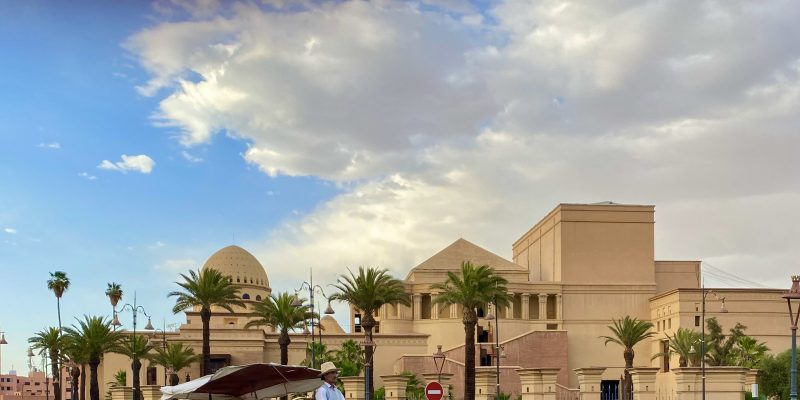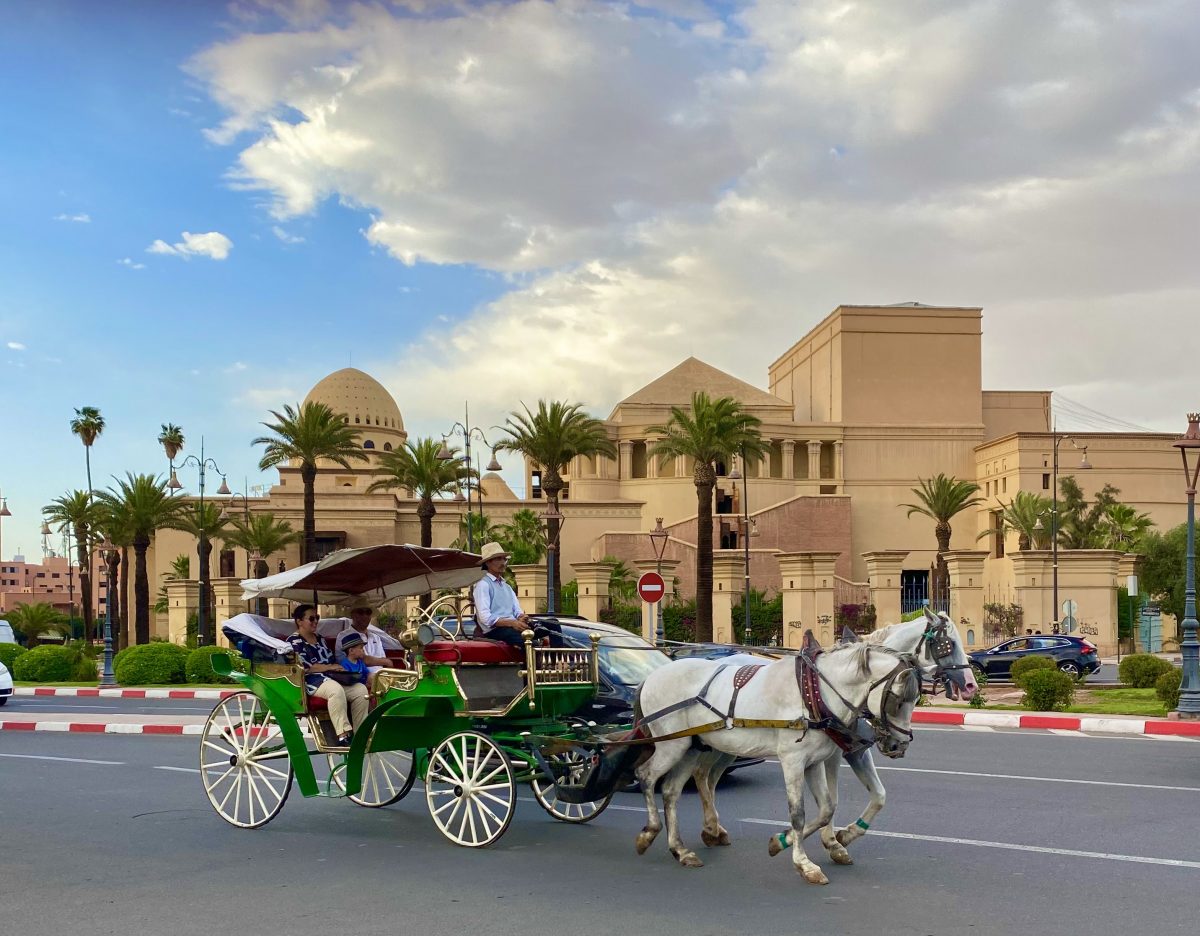Story & Photos By Barbara Ramsay Orr |
The ‘Paris of the Sahara’, as Marrakesh is often described, is a painter’s dream, with a natural palette of colours that would make any artist’s fingers itch. Delacroix, Dali, Matisse, John Singer Sargent, and that amateur watercolour dabbler, Winston Churchill, all were seduced by the kaleidoscope of colour in this city.
The Parisian designer Yves Saint Laurent (YSL) made Marrakesh his second home after discovering its seductive charms. “This city taught me colour,” the designer declared. He was so entranced that he came regularly to the city to design his collections, accompanied by his partner Pierre Bergé.
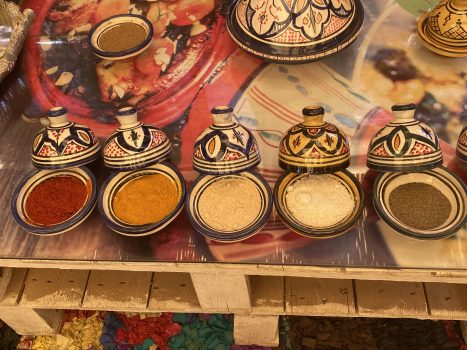 While Marrakesh is a feast for the eyes, it’s so much more. In addition to being movie-star beautiful, there’s the shopping paradise of the souks, the historic palaces and secret riads (a riad is a traditional Moroccan building form with interior courtyards) in the medina, important museums, and the intoxicating spices of Moroccan cuisine.
While Marrakesh is a feast for the eyes, it’s so much more. In addition to being movie-star beautiful, there’s the shopping paradise of the souks, the historic palaces and secret riads (a riad is a traditional Moroccan building form with interior courtyards) in the medina, important museums, and the intoxicating spices of Moroccan cuisine.
Shopping in the Souks
In the medina, behind ancient rose-tinted city walls, lie the busy souks for which Marrakesh is famous. I spent most of one morning wandering through the narrow passageways, luckily hampering myself from buying too much because I travel with only carry-on luggage. I was tempted by bejewelled leather slippers, gauzy scarves in every colour, gorgeous carpets, and every size of tagine, the ubiquitous Moroccan cooking pot – from little ones for salt to jumbo ones for the oven. There was fresh bread and tables of bowls of brightly coloured spices.
Motorcycles and donkey carts moved through the narrow alleys. The medina is a warren and it was easy to lose my way. I was adrift with no idea how to get back to my starting point when a juice vendor detected my confusion. Learning I was from Canada, he gave me directions in French, and I had to explain that not all Canadians speak French fluently. He switched seamlessly to English and, along with a glass of freshly squeezed orange juice, gave me directions to the main square.
To Do/See
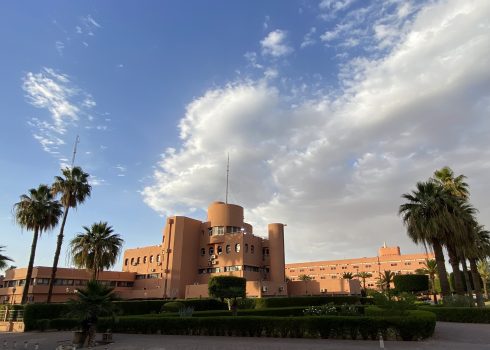 The square, Jamaa el-Fna, has been designated by UNESCO as one of the Masterpieces of the Oral and Intangible Heritage of Humanity. It’s a preserved space where the oral culture and traditions of the country still flourish. During the day the place teems with activity but for a glimpse of Moroccan nightlife, go after dark, when the square truly comes alive with fortune tellers, henna artists, snake charmers, dancers and musicians, including Gnawa artists playing the North African rhythms that have inspired so many trends in world music.
The square, Jamaa el-Fna, has been designated by UNESCO as one of the Masterpieces of the Oral and Intangible Heritage of Humanity. It’s a preserved space where the oral culture and traditions of the country still flourish. During the day the place teems with activity but for a glimpse of Moroccan nightlife, go after dark, when the square truly comes alive with fortune tellers, henna artists, snake charmers, dancers and musicians, including Gnawa artists playing the North African rhythms that have inspired so many trends in world music.
Another important attraction is the Bahia Palace inside the old city walls. A tour of the multiple riads that make up the palace gave me a glimpse into the private life of the sultans and Moroccan aristocracy. The palace sprawls across two hectares, with inner courtyards, intricate gardens and richly ornamented rooms.
My guide pointed out that in the past, the women of the harem would have no need or desire to go outside the palace walls. “Artisans came into the palace to make clothes and jewelry for the women. There was fine food and the best music and the companionship of family – but none of the windows faced outside the riad.” The palace is said to be named after the original owner’s favourite wife, Al Bahia, meaning ‘the Brilliant’. Close by is the El Badi, a vast ‘palace of wonder’ that now lies in ruins. Today its reflecting ponds, sunken gardens and courtyards are used for festivals and exhibitions.
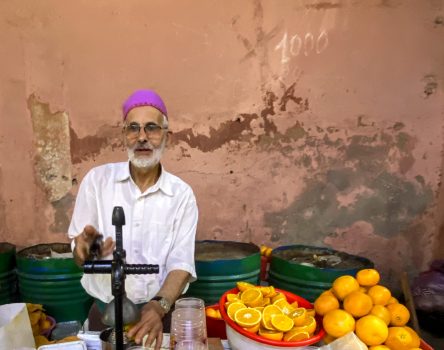 Not to be missed is the garden and villa that belonged to YSL and his partner who were responsible for the resurrection and rescue of the villa and gardens created by French painter Jacques Majorelle, which had been left to decay after the painter’s death. The Jardin Majorelle is one of the world’s most beautiful gardens today.
Not to be missed is the garden and villa that belonged to YSL and his partner who were responsible for the resurrection and rescue of the villa and gardens created by French painter Jacques Majorelle, which had been left to decay after the painter’s death. The Jardin Majorelle is one of the world’s most beautiful gardens today.
Inside the Jardin Majorelle, I walked through flowering trees, and alongside flower-encircled ponds stocked with koi. Most captivating were the walls saturated in a deep blue colour, invented and patented by Majorelle. It’s a glorious rich blue pigment based on the hues the artist saw used in traditional designs in the city, and a colour that still bears his name.
Against the blue walls, the intensity of yellow planters, pink bougainvillea and purple jasmine is spectacular. Visits to the garden, the Berber Museum and the YSL Museum are top of the must-see list for most visitors to the city.
The common image of Marrakesh is of ancient palaces and the medina, but other parts of the city are modern and decidedly glamorous. In the Ville Nouvelle, the area of the city that most retains the influence of the French protectorate years, the architectural elements of this Berber city have been kept deliberately but have been blended with Art Deco sophistication. The result is gorgeous. It’s well worth spending time exploring the Ville Nouvelle and Gueliz to absorb the push and pull of old and new.
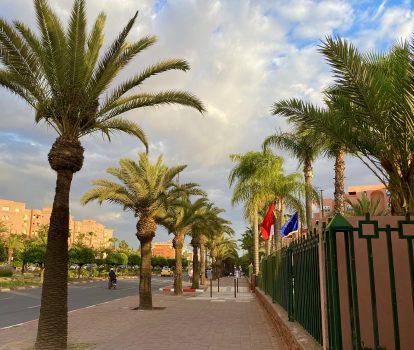 In the neighbourhood of Hivernage, where I was staying, the vibe was contemporary with art deco buildings, all finished in the warm shades of local red clay, which have earned Marrakesh the sobriquet, The Red City. Against the big blue desert sky, with the snow-capped Atlas Mountains hovering in the distance, the buildings lining Boulevard Mohammed VI were rosy pink in the late afternoon light. There were gardens all along the streets, and when I was there in April every tree seemed to be in flower – oleander, bougainvillea, jasmine and jacaranda.
In the neighbourhood of Hivernage, where I was staying, the vibe was contemporary with art deco buildings, all finished in the warm shades of local red clay, which have earned Marrakesh the sobriquet, The Red City. Against the big blue desert sky, with the snow-capped Atlas Mountains hovering in the distance, the buildings lining Boulevard Mohammed VI were rosy pink in the late afternoon light. There were gardens all along the streets, and when I was there in April every tree seemed to be in flower – oleander, bougainvillea, jasmine and jacaranda.
To Experience
Moroccan food is healthy and flavourful, laced with dozens of spices, and dishes are simple but time-consuming, as I learned in a cooking class at the Atelier de Cuisine Chef Tarik. The celebrated local chef offers cooking classes in an authentic tented kitchen and dining area out in the desert. We learned how to make four different tagines, several vegetable salads and couscous. We became familiar with the wonderful mix of Moroccan spices, like cinnamon, cumin, turmeric and Ras el Hanout, a blend of up to 36 spices. Plus, we learned how important sharing food with friends and family is in Moroccan culture.
To Dine
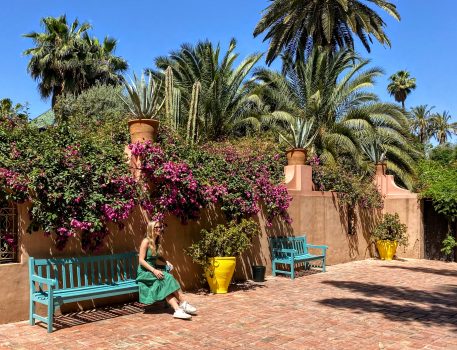 In the rooftop restaurant of Riad Kniza, I savoured lamb tagine, couscous and multiple salads, and finished up with a glass of mint tea as the call to prayer echoed over the city.
In the rooftop restaurant of Riad Kniza, I savoured lamb tagine, couscous and multiple salads, and finished up with a glass of mint tea as the call to prayer echoed over the city.
The Jardin du Lotus in the old medina has an open-air patio with flowering trees and a good cosmopolitan menu. It looked like a jumping place for after-hours too. As I left, young couples were arriving, the DJ was warming up beside the reflecting pool and the tables were full.
I drove out to Lake Lalla, a man-made body of water about 40 minutes from Marrakesh, which is a mecca for locals. Casa Lalla is a muted treasure perched above the lake that serves European and Moroccan dishes, like grilled branzino and seafood paella, with great style.
To Stay
I stayed at the Mövenpick, a five-star hotel designed in Moroccan style but with all of the modern amenities one could want.
Some of the traditional riads have become boutique hotels and they’re excellent places to stay for getting an authentic feel for Moroccan life. The Riad Kniza, with only 11 rooms, is a gem in the middle of the medina that has attracted celebrities, politicians, and royalty. Tom Cruise, The Clintons, Ronald Regan, and Will Smith all have hidden out here.
Dar Rhizlane is another upscale riad, a former private villa in the Gueliz area that has been transformed into a 20-room romantic palace-hotel. There are fountain-filled gardens, a large pool and an excellent restaurant.
For a special experience, I travelled out to the Agafay Desert to Le Bedouin Camp to sleep in a tent. But it wasn’t your ordinary tent. It wasn’t tent-like at all but had a king-sized bed, a modern bath, WiFi, and a balcony on which I could sit to watch the sunset. It felt like the height of luxury to lounge by a swimming pool in the middle of the desert. A camel ride before dinner was the perfect way to end a busy day. The camels were docile, the views awesome and a rainbow appeared just as the ride finished.
Things to Know
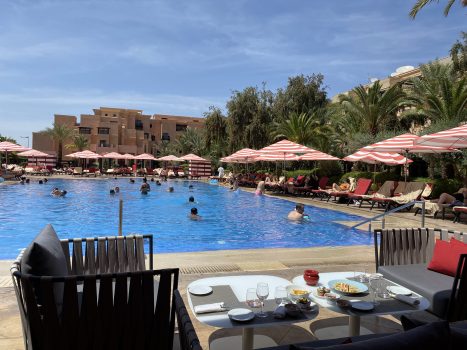 Don’t worry about the necessity for women to cover up in Marrakesh. At a traffic light on Boulevard Mohammed VI, I watched two girls on a motorcycle waiting for the light to turn – one dark and bare-headed and the other sporting bright red spiky hair. They seemed like a symbol of the more liberal Marrakesh of today. Outside the city, in smaller villages, customs remain more conservative and virtually all women had their heads covered, but, as a visitor, I felt no pressure to cover up.
Don’t worry about the necessity for women to cover up in Marrakesh. At a traffic light on Boulevard Mohammed VI, I watched two girls on a motorcycle waiting for the light to turn – one dark and bare-headed and the other sporting bright red spiky hair. They seemed like a symbol of the more liberal Marrakesh of today. Outside the city, in smaller villages, customs remain more conservative and virtually all women had their heads covered, but, as a visitor, I felt no pressure to cover up.
The Moroccan cure for jet lag is a hammam experience. A flight from Canada to Morocco is over eight hours. To reduce jet lag, schedule a visit to a hammam. I was steamed, rubbed, massaged and oiled at Bain du Lotus just a few hours after landing and felt no ill effects of travelling at all.
If you visit the souks, go early in the morning to avoid the crowds.
If you visit the Jardin Majorelle, book your appointment ahead of time online and book it either for the opening hours or late in the day. The garden gets very busy.
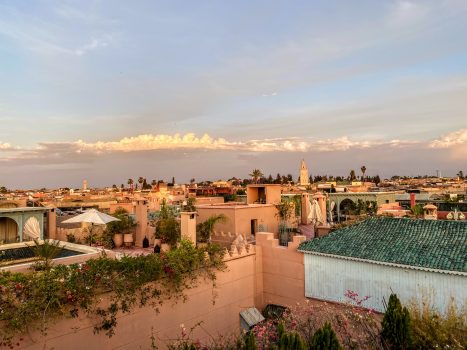 Most direct flights to Morocco from Canada land in Casablanca. Marrakesh is a three-hour drive from there.
Most direct flights to Morocco from Canada land in Casablanca. Marrakesh is a three-hour drive from there.
Bottom Line
Marrakesh is the hottest place to visit right now for several reasons – it’s an exotic locale but still very safe for visitors, it’s affordable, and it’s stable and welcoming to tourists.
It’s profoundly memorable on so many different levels. And yes, I did buy a tagine.
